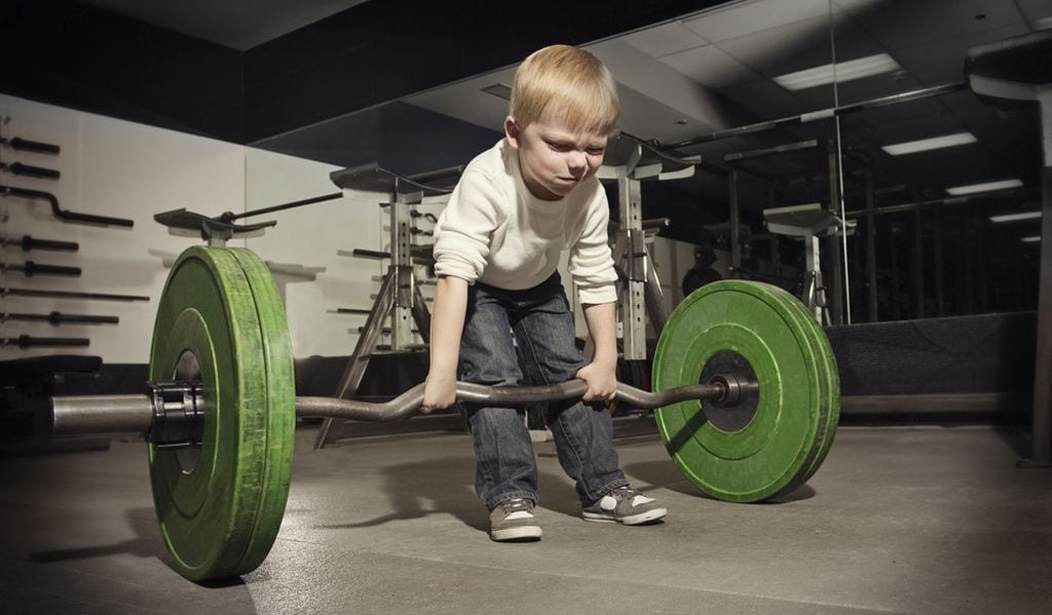We do seminars all over the country, every month. We have an extensive question-and-answer session following the rather long weekend, which includes several detailed lectures and a practical exposure to the five main barbell exercises.
Every time, without fail, someone asks the question: Can my kids train for strength?
Can they do the squat, press, and deadlift with me when I go to the gym?
Sure, they can do the exercises. There is nothing any more dangerous about a squat, a press, or a deadlift for a child than there is for an adult — which is to say, there is nothing dangerous about perfectly natural human movement patterns for any human of any age, unless they are performed incorrectly. And really, people do them wrong all the time and don’t get hurt, so they’re just not that dangerous. If they were, everybody at every Big Chain Fitness gym would be injured, and they’re not all injured.
The only caveat is that kids are not very good at the eccentric portions of these movements — they are not good at the “lowering the bar” parts of the exercises. They tend to slam down into the bottom of the squat too fast, and lower the bar in the press and the deadlift without good control. They have to be taught the patience to do these movements correctly. So kids can go to the gym with their parents and do properly instructed squats, presses, and deadlifts.
But, they cannot train the lifts in the same sense that their parents should be training for strength.
Training is the process of becoming stronger — the intentionally designed accumulation of greater strength over time. This is usually and most efficiently accomplished by adding a little bit of weight to a selected few exercises that work the most possible muscle mass over the greatest effective range of motion, exercises that therefore allow you to lift slightly heavier weights each workout, and thus become stronger.
This process is predicated on the famous General Adaptation Syndrome, first described in 1936 by Hans Selye, and which is a feature of all living organisms. When stress is applied to the living system, the organism either adapts to the stress or it dies. Since we don’t want to die in the gym, the stress we apply in training is small enough to not kill you, but large enough (just a little more than the last workout) to make you adapt — to make you get stronger.
The training process depends on the stress/recovery from the stress/adaptation sequence. The recovery part of the process is required for the adaptation. The recovery phase is when the adaptation takes place. Not dying happens when the stress is recovered from, and is in itself a complex biological response, the purpose of which is to ensure the continued existence of the organism in the new environment the stress has created.
This is very important, so write it down: You don’t get strong from lifting weights. You get strong by recovering from lifting weights.
The problem is that kids can’t recover from enough stress to make the system adapt over time the way adults can.
In the weight room, the stress is the heavier weight you lifted, and the adaptation is the ability to lift the heavier weight. As long as the weight you attempt to lift isn’t so heavy that it does more damage than you can repair, your ability to adapt to gradually increasing weight will continue for a long time. This is the process we call training, and the stress of the heavier weight, your ability to recover from having lifted it, and the new strength level this process produces is the most productive physical process you can undertake. As I’ve said many times, strength is the most important physical adaptation.
You know this, and you want to take your kids to the gym so they can have some too. But kids are not adults, as you know. They aren’t as smart, experienced, wise, patient, educated, big, tall, or strong as adults. Kids have obviously been growing, from toddler to pre-adolescent, but the growth has been slow and steady. The explosive growth process by which kids become physical adults — puberty — involves many changes in their biology. Among the most important, and the ones that primarily drive all the others, are hormonal. Testosterone, estrogen, and their related compounds, as well as growth hormone and its related compounds are referred to as the “hormonal milieu.”
As a kid progresses through puberty, changes in the hormonal milieu are reflected in the kid’s appearance of maturity. This is measured by the Tanner Scale of physical maturation, and Wikipedia is your friend here. Not only is the maturation of a child indicated by the physical appearance of maturity, it is also indicated by the individual’s ability to grow — maturity is accompanied by growth.
Recovery from stress, especially physical stress, is a function of the ability to grow.
New muscle tissue, denser bone, thicker tendons and ligaments, and the adaptation of the nervous system are all growth processes that are quite relevant to strength training. Kids need to be at about Tanner Stage IV before they can productively engage in the strength training process. Prior to this, they can’t recover well enough to facilitate the process.
Kids can safely go to the gym and do the exercises for the sake of having fun. This is in fact the same thing done by most adults who go to the gym, and there’s absolutely nothing wrong with it. If the kid views it as play, and the parents have enough sense to let it be play, that’s just fine. Adults who do this are, in my opinion, wasting time that could be spent more productively by actually training, because the deliberate process of getting stronger benefits every other physical parameter, and more effectively accomplishes the purpose of going to the gym.
But kids can’t train, because they can’t recover.
If you try to add weight to a kid’s lifts every time you take him to the gym, he will get injured. He will get mad at you. And he will not get stronger like you can, because he’s a kid. Kids should be allowed to just play, as long as they play safely. That’s what childhood is for, and you only get to be a kid once. There will be plenty of time to train later, but now, let’s have a dirt clod fight, build a fort, and maybe do some squats with dad. As long as it’s fun.









Join the conversation as a VIP Member